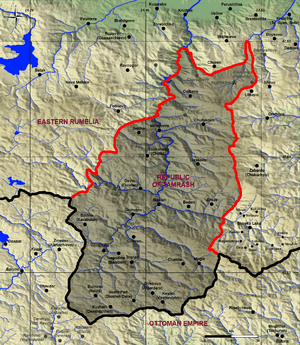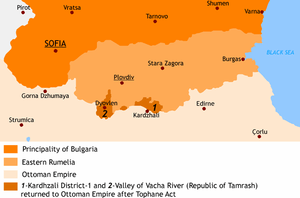Republic of Tamrash


The Republic of Tamrash (Bulgarian: Тъмръшка република, translit. Tǎmrǎška republika), was a short-lived self-governing administrative structure of the Pomaks, living in the Tamrash region of the Rhodope Mountains. It existed from 1878 to 1886.
Geography
The territory spanned over the area locked in the upper valley of the Vacha River and most of its tributaries. The rebel territory initially consisted of 17 villages but its number increased up to 21 in 1880. Some of those villages were Trigrad, Mugla, Beden, Mihalkovo, Skoblevo, Churukovo and Devin.
History
The self-governing territory emerged as the Pomaks of the Tamrash region struggled to avoid the influence and the rule of the Christian Bulgarians and the Russians after the Russo-Turkish War.
President of the territory was Ahmed Agha Tamrashlyata. After the Russian army withdrew from the hard to supply Rhodope Mountains, the agha and his party returned to their villages to establish the self-governing territory.
The republic survived until 1886, when Eastern Rumelia was incorporated into Bulgaria.[1]
Timeline
- 1878 - the self-governing territory of Tamrash is established.
- 1880 - the leaders of the territory agree to join Eastern Rumelia, but don't do it because they are afraid of forest bandits who would attack them had they disarmed.
- 1880 - four more Pomak villages join their rebellious brothers.
- 1880 - after negotiations the four villages are returned to Eastern Rumelia.
- 1882 - Eastern Rumelia gives up its efforts to gain control over Tamrash.
- 1886 - the Bulgarian Army occupies the territory of Tamrash.
- 1886 - the Ottoman Empire recognizes the unification of Eastern Rumelia and Bulgaria and in return receives the Republic of Tamrash and several rebellious Turkish villages.
See also
Literature
- Мехмед, Хюсеин (2007). Помаците и торбешите в Мизия, Тракия и Македония (in Bulgarian). София. p. 167. Archived from the original on 2009-10-26.
References
- ↑ Olga Demetriou (2013). "The Politics of Genealogy". Capricious Borders: Minority, Population, and Counter-Conduct Between Greece and Turkey. Berghahn Books. p. 92.